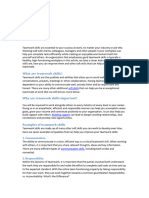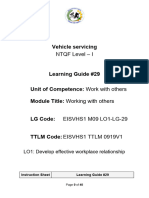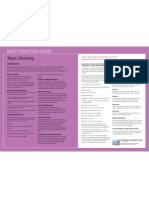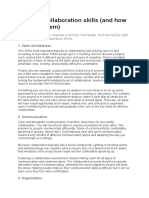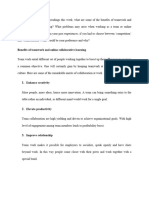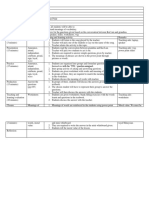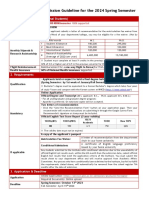Effective-Collaboration - Meeting 11 - 13
Effective-Collaboration - Meeting 11 - 13
Uploaded by
Bisa AdalahCopyright:
Available Formats
Effective-Collaboration - Meeting 11 - 13
Effective-Collaboration - Meeting 11 - 13
Uploaded by
Bisa AdalahOriginal Title
Copyright
Available Formats
Share this document
Did you find this document useful?
Is this content inappropriate?
Copyright:
Available Formats
Effective-Collaboration - Meeting 11 - 13
Effective-Collaboration - Meeting 11 - 13
Uploaded by
Bisa AdalahCopyright:
Available Formats
Business magazine
Effective collaboration
What are the benefits of working collaboratively and how can we work together more
effectively?
Before reading
Do the preparation task first. Then read the article and do the exercises.
Preparation task
Match the definitions (a–h) with the vocabulary (1–8).
Vocabulary Definition
1. …… contribution a. the position or fact of being a leader, the qualities of a
2. …… productivity good leader
3. …… expertise b. to develop a close connection to or strong relationship
with someone
4. …… to set an example
c. interested in personal relationships
5. …… to stay focused
d. to keep giving attention to one particular thing
6. …… leadership
e. something that you give or do to achieve something with
7. …… relationship-
other people
oriented
f. a high level of knowledge or skill in a particular subject
8. …… to bond with
someone g. the rate at which a person or company produces things or
does useful work
h. to behave in a way that other people should copy
Effective collaboration
Collaboration means two or more people working together to achieve a goal. Studies have
found that working together makes people more motivated and helps them perform much
better. People who are collaborating on tasks stay interested for longer, feel less tired and get
better results than people who are working alone.
Working together as a team allows people to achieve things that could never be done by just
one person. What’s more, the communication needed in order for team members to share
goals and explain ideas is part of a process that improves the quality of everyone’s thinking
and contributions.
Here are five tips for effective collaboration and strong teamwork that will improve
productivity and get better results.
© British Council 2020 www.britishcouncil.org/learnenglish
1. Creating a culture of co-operation
To achieve their goals effectively, team members need to co-operate and be generous with
their resources, including their own talents. When people get to know the strengths of their
individual team members, they can use the different skills and expertise in the team to their
advantage.
Team leaders can create a culture of co-operation by setting an example that includes
spending time talking to and supporting individuals, and sharing their knowledge and
resources with their team. If we see our team leaders being open and welcoming different
ideas, we are more likely to do the same.
2. Having clear goals and clear roles
Working in a team without clear goals is like running in a race without a finish line. In order for
team collaboration to be successful, members need to have clear goals and know their
individual responsibilities. This not only helps them to stay focused and motivated, but it also
helps them to understand how they can play their part in the team’s success.
3. Leaders – focusing on tasks and relationships
Objectives are important, but we mustn’t forget that a team is made up of people and their
relationships to each other. The stronger those relationships are, the more likely the team is
to be effective.
A report by Harvard Business Review found that the most productive and innovative teams
often have leaders with a flexible leadership style. They might start a project being task-
focused and deciding the goals and roles in a team. But during the project, they might switch
to a more relationship-oriented style, focusing on team-building and creating an environment
of friendliness and trust.
4. Having open communication lines
If we want our team members to work well together, communication is the key. We need to
provide effective channels of communication and encourage people to share what they’re
doing. Simply meeting once a week for updates is not enough. There are many project
management tools like Microsoft Teams or Slack that provide a regular and open channel of
communication with everyone. Another option could be creating a group on messaging apps
like WhatsApp or LINE to offer team members a chance to informally communicate with
others.
5. Encouraging a spirit of community
Companies often organise social events because they know the importance of creating a
sense of community. The activity could be anything from a weekly lunchtime food share to a
quiz afternoon. Or you can start with simple, everyday things like having coffee breaks
together or creating a space to share books. Ideas like these all encourage collaboration by
bringing people together and helping them bond with their colleagues.
Collaboration is an opportunity to learn from each other and encourage fresh thinking, as well
as a source of energy, strength and continued effort. As the saying goes, ‘If you want to go
fast, go alone. If you want to go far, go together.’
© British Council 2020 www.britishcouncil.org/learnenglish
Tasks
Task 1
Which ways of improving collaboration are mentioned in the article? Choose the five correct
answers.
Spending time talking to team members and giving them help.
Organising a fun group activity for staff.
Encouraging each team member to compete against the others.
Making sure each team member understands their role in the project.
Limiting communication to weekly team meetings.
Focusing on the goals but also on the relationships that team members have with
each other.
Ensuring that everyone on the team has the same point of view.
Encouraging informal communication and socialising between colleagues.
Task 2
Write the correct form of the word in brackets.
1. When two or more people work together to achieve the same goal, it is called
………………………………… . (collaborate)
2. To achieve their goals …………………………………, team members need to share their resources.
(effective)
3. Strong teamwork and effective collaboration will improve ………………………………… and get better
results. (produce)
4. When people get to know the strengths of the people in their team, they can use their
different skills and ………………………………… to their advantage. (expert)
5. The most productive and innovative teams often have leaders with a flexible
………………………………… style. (leader)
6. There are many project ………………………………… tools that can provide a regular and open
channel of communication with everyone. (manage)
7. Creating a group on messaging apps like WhatsApp or LINE offers team members a chance
to communicate ………………………………… with others. (formal)
8. Collaboration is a source of energy, ………………………………… and continued effort. (strong)
Discussion
What other things do you think can help with collaboration in a team?
© British Council 2020 www.britishcouncil.org/learnenglish
You might also like
- MODULE TITLE: Working in Team Environment LO1:: Describe Team Role and ScopeDocument11 pagesMODULE TITLE: Working in Team Environment LO1:: Describe Team Role and Scopemelesse bisema100% (4)
- Teamwork GuideDocument20 pagesTeamwork GuideSuchismita Mangraj100% (1)
- The Contract Management StandardDocument10 pagesThe Contract Management StandardAdil IqbalNo ratings yet
- B2 - Business. Effective CollaborationDocument4 pagesB2 - Business. Effective CollaborationFlorencia SanseauNo ratings yet
- TEXT ANALYSIS - Licence 2 Sces Eco (2022 - 2023)Document1 pageTEXT ANALYSIS - Licence 2 Sces Eco (2022 - 2023)Yougel TraoreNo ratings yet
- 2 Unit 1 (Extra)Document12 pages2 Unit 1 (Extra)kimngangs1607No ratings yet
- Assignment 1Document12 pagesAssignment 106-Nguyễn Minh HàNo ratings yet
- Assignment 3 ManagementDocument5 pagesAssignment 3 Managementlaiba saleemNo ratings yet
- Great Leadership Skills of Project ManagementDocument8 pagesGreat Leadership Skills of Project Managementlram70No ratings yet
- Collaborative TeamingDocument9 pagesCollaborative Teamingapi-513882663No ratings yet
- Teamwork: in Cooperative Extension ProgramsDocument32 pagesTeamwork: in Cooperative Extension ProgramsJoe GottNo ratings yet
- Case Study 4Document5 pagesCase Study 4Anna GongNo ratings yet
- 7 Examples of Important Teamwork SkillsDocument4 pages7 Examples of Important Teamwork SkillsMariem SalehNo ratings yet
- Catacutann - Teams and TeamworkDocument4 pagesCatacutann - Teams and Teamworkapi-561686395No ratings yet
- Business CommunicationDocument7 pagesBusiness CommunicationAnh Thu VuNo ratings yet
- MO9 Work W OthersDocument39 pagesMO9 Work W OtherstselothaiilemariamNo ratings yet
- UntitledDocument2 pagesUntitledAfwork atsaNo ratings yet
- What Is A Team?Document5 pagesWhat Is A Team?Bryle James BialaNo ratings yet
- Lead Small Team FinalDocument14 pagesLead Small Team FinalEmente EmenteNo ratings yet
- Chapter 8Document6 pagesChapter 8asrat bayuNo ratings yet
- BSBLDR801 PPT Day 9Document23 pagesBSBLDR801 PPT Day 9Manpreet KaurNo ratings yet
- Reflective form-PLA Spring 2021 BMM4000 Part 2: ReflectionDocument5 pagesReflective form-PLA Spring 2021 BMM4000 Part 2: ReflectionSierra NovNo ratings yet
- AdmasDocument5 pagesAdmaswoyni negeNo ratings yet
- ENGLISH _merged (2) (1)Document69 pagesENGLISH _merged (2) (1)RushabhNo ratings yet
- Landscaping Installation and Maintenance NC-11: Learning Activity Sheet Quarter 1 - Week 1-2Document20 pagesLandscaping Installation and Maintenance NC-11: Learning Activity Sheet Quarter 1 - Week 1-2Dary CadungaNo ratings yet
- PR Ése Ntation BeDocument10 pagesPR Ése Ntation Beameni.hamdi14No ratings yet
- Small Lead TeamDocument13 pagesSmall Lead Teamnatnael denekeNo ratings yet
- BUS 5113 - Unit - 6 - The Art of Working With Teams - DA1Document9 pagesBUS 5113 - Unit - 6 - The Art of Working With Teams - DA1NaderYasenHNo ratings yet
- Reflective form-PLA Spring 2021 BMM4000 Part 2: ReflectionDocument6 pagesReflective form-PLA Spring 2021 BMM4000 Part 2: ReflectionSierra NovNo ratings yet
- Effective CollaborationDocument4 pagesEffective CollaborationShi LumauanNo ratings yet
- Title: Group Work Vs Team Work: Kurdistan Regional Government - IraqDocument8 pagesTitle: Group Work Vs Team Work: Kurdistan Regional Government - IraqAri AwnyNo ratings yet
- Teamwork Skills CourseDocument8 pagesTeamwork Skills Coursedgmtutlfg100% (2)
- Team WorkingDocument1 pageTeam WorkingFranklin SondakhNo ratings yet
- Interpersonal Communication Skills For MBA StudentsDocument32 pagesInterpersonal Communication Skills For MBA Studentsdhananjay1050No ratings yet
- How To Built Successful Work Team in OrganizationDocument20 pagesHow To Built Successful Work Team in OrganizationAnkit ShahNo ratings yet
- Kurdistan Regional GovernmentDocument8 pagesKurdistan Regional GovernmentAri AwnyNo ratings yet
- 6 Crucial Collaboration Skills ArticleDocument3 pages6 Crucial Collaboration Skills ArticleKolynNo ratings yet
- Cooperation: "Cooperation Is Always Better Than Competition." - Bob ProctorDocument10 pagesCooperation: "Cooperation Is Always Better Than Competition." - Bob ProctorJacob PateroNo ratings yet
- Review of (Effective - Leadership - Is - All - About - Communicating - Effectively - Luthra - Dahiya - 2015) by Mansoor SalihiDocument4 pagesReview of (Effective - Leadership - Is - All - About - Communicating - Effectively - Luthra - Dahiya - 2015) by Mansoor SalihiMansoor SalihiNo ratings yet
- Team: How Getting Things Done with Others Key Lessons and How to Put Them into PracticeFrom EverandTeam: How Getting Things Done with Others Key Lessons and How to Put Them into PracticeNo ratings yet
- Participate in Workplace CommunicationDocument8 pagesParticipate in Workplace CommunicationNatnael AlemayehuNo ratings yet
- Alex Parmar - Assignment 6_ Reflection Paper - SCS1952, Leading Projects in OrganizationsDocument6 pagesAlex Parmar - Assignment 6_ Reflection Paper - SCS1952, Leading Projects in Organizationsalex.parmar9No ratings yet
- LEC 2 EthicsDocument34 pagesLEC 2 Ethicssally.sharaf1No ratings yet
- Unit -5 _ Group Behaviour and Leadership – B.C.a StudyDocument8 pagesUnit -5 _ Group Behaviour and Leadership – B.C.a Studymr6121587No ratings yet
- OD Project SamuelDocument16 pagesOD Project Samuelsamuel gebrelibanosNo ratings yet
- Crucial Collaboration Skills and How To Foster Them by Corey MoseleyDocument5 pagesCrucial Collaboration Skills and How To Foster Them by Corey MoseleyAlessandra ApuyaNo ratings yet
- Ways To Improve Interpersonal Communication in The WorkplaceDocument3 pagesWays To Improve Interpersonal Communication in The WorkplaceKhushali PoddarNo ratings yet
- Benefits of Team Role 0 Balancing Skills WithinDocument6 pagesBenefits of Team Role 0 Balancing Skills Withinwifoli8542No ratings yet
- Management Asgn 3Document14 pagesManagement Asgn 3Šÿêdà PäkëēžâNo ratings yet
- 鼓励的重要性Document7 pages鼓励的重要性1941965174No ratings yet
- Personal Development Plan Youchun2Document4 pagesPersonal Development Plan Youchun2api-659743702No ratings yet
- TERM PAPER - NGUYỄN HOÀNG THIỆN NHÂNDocument12 pagesTERM PAPER - NGUYỄN HOÀNG THIỆN NHÂNThiện NhânNo ratings yet
- Teamwork and LeadershipDocument31 pagesTeamwork and LeadershipFrank Korang-DanquahNo ratings yet
- AssessmentDocument8 pagesAssessmentgaurikasinghchauhanNo ratings yet
- Concept of Team CollaborationDocument10 pagesConcept of Team CollaborationLee BuelaNo ratings yet
- University of Caloocan CityDocument4 pagesUniversity of Caloocan CityElliorb Yseer NlaatacarNo ratings yet
- Project Teamwork - PDFDocument11 pagesProject Teamwork - PDFSnehasis JanaNo ratings yet
- Work in Team Hand OutDocument9 pagesWork in Team Hand Outshucayb cabdiNo ratings yet
- When Thinking About Your Readings This WeekDocument3 pagesWhen Thinking About Your Readings This WeekLets PlayNo ratings yet
- Week 6 - Discussion AssignmentDocument3 pagesWeek 6 - Discussion AssignmentNkongnenwi AlainNo ratings yet
- Chapter 10 WWDocument2 pagesChapter 10 WWAngel Parto - LuceroNo ratings yet
- Comparison/Contrast Paragraphs: OrganizationDocument17 pagesComparison/Contrast Paragraphs: OrganizationN TNo ratings yet
- Pharmacy TechnicianDocument4 pagesPharmacy TechnicianRaisa Chernysheva100% (1)
- Pencerapan Bahasa InggerisDocument2 pagesPencerapan Bahasa InggerisluiyilungNo ratings yet
- Factors Affecting The Choice of College Courses: Their Impacts To Students' Present StudiesDocument4 pagesFactors Affecting The Choice of College Courses: Their Impacts To Students' Present StudiesmarvinNo ratings yet
- COMMISSION ON ELECTIONS-Election Officer IIIDocument1 pageCOMMISSION ON ELECTIONS-Election Officer IIINabilaNo ratings yet
- Slides Phonics WonderlandDocument15 pagesSlides Phonics WonderlandYung Siok YiiNo ratings yet
- History of Naushahro FerozeDocument8 pagesHistory of Naushahro FerozeSaadat Ali RizviNo ratings yet
- Experiment No 7 CMTDocument5 pagesExperiment No 7 CMTFrancis ArcillaNo ratings yet
- Dokumen - Tips - Dhiraj Ms Cit CertificateDocument1 pageDokumen - Tips - Dhiraj Ms Cit Certificatea KhanNo ratings yet
- RefMan Forms Spring2017 V2Document120 pagesRefMan Forms Spring2017 V2PatrickNo ratings yet
- كتاب دليل معلم ديسكفر للصف الثالث الابتدائي الترم الاول 2021Document298 pagesكتاب دليل معلم ديسكفر للصف الثالث الابتدائي الترم الاول 2021Haitham HassanNo ratings yet
- Basic Leadership TrainingDocument38 pagesBasic Leadership TrainingHenry Cadano HernandezNo ratings yet
- 2011 CIMA Certificate in Business Accounting Syllabus Frequently Asked QuestionsDocument7 pages2011 CIMA Certificate in Business Accounting Syllabus Frequently Asked QuestionsMelita Rudo Ncube ZhuwararaNo ratings yet
- Final Best Research Chapter One-FiveDocument108 pagesFinal Best Research Chapter One-FivealeNo ratings yet
- (Guideline) GIST Graduate Admissions - 2024 Spring SemesterDocument1 page(Guideline) GIST Graduate Admissions - 2024 Spring SemesterSusanne DamierNo ratings yet
- Classroom Language ExercisesDocument2 pagesClassroom Language ExercisesDeborah Barria67% (3)
- Yendada SchoolsDocument4 pagesYendada Schools21131A0519 BEHARA HARININo ratings yet
- CS583 Supervised LearningDocument147 pagesCS583 Supervised LearningNghe NhinNo ratings yet
- METGo Example Items BookletDocument8 pagesMETGo Example Items Bookletanniipazz64No ratings yet
- Technical - Vocational Education Semi Detailed Lesson Plan in Consumer Electronics Servicing Iv (Full Wave Bridge Type Power Supply)Document4 pagesTechnical - Vocational Education Semi Detailed Lesson Plan in Consumer Electronics Servicing Iv (Full Wave Bridge Type Power Supply)Jeh UbaldoNo ratings yet
- FAQs Lifelong LearnersDocument5 pagesFAQs Lifelong LearnersDeped TambayanNo ratings yet
- raunak projectDocument1 pageraunak projectSahil SinghNo ratings yet
- Brigada Pagbasa Tool Kit - March 5Document28 pagesBrigada Pagbasa Tool Kit - March 5Renelou Villador Lopez100% (1)
- Reiterating Adherence To and Strict Compliance of The Department of EducationDocument12 pagesReiterating Adherence To and Strict Compliance of The Department of Educationsir jjNo ratings yet
- Stretch - Stretchy SnakeDocument50 pagesStretch - Stretchy SnakeNeha JainNo ratings yet
- DE CHUAN MINH HOA 2021 - NGUYỆTDocument9 pagesDE CHUAN MINH HOA 2021 - NGUYỆTPhạm Thi Như NguyệtNo ratings yet
- M7a1 Lesson Plan - Initial SubmissionDocument2 pagesM7a1 Lesson Plan - Initial Submissionapi-286259630No ratings yet
- 2022-Game-Based Learning LAC SessionDocument10 pages2022-Game-Based Learning LAC SessionAltJonas CabusbusanNo ratings yet
- Final Report LMI Pakistan 2011 12 27Document76 pagesFinal Report LMI Pakistan 2011 12 27Sardar AhmadkhanNo ratings yet












